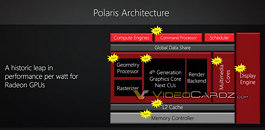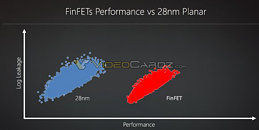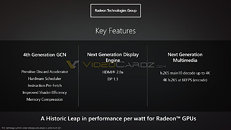Jul 6th, 2025 12:23 CDT
change timezone
Latest GPU Drivers
New Forum Posts
- Do you still use Antivirus software on your latest hardware? (21)
- Would ESD damage my motherboard easily? (14)
- What's the best ways to test a USB stick for malware and speed? (0)
- How about AMD instead of Intel? (35)
- The Last of Us - technical problems (0)
- Overheating and underperforming. (1)
- RX 9070 XT freezing/locking up only on desktop, anyone else? (12)
- Stalker enhanced editions - WTF is this abomination? (15)
- Frametime spikes and stuttering after switching to AMD CPU? (525)
- My PSU died.. (22)
Popular Reviews
- NVIDIA GeForce RTX 5050 8 GB Review
- Fractal Design Scape Review - Debut Done Right
- Crucial T710 2 TB Review - Record-Breaking Gen 5
- ASUS ROG Crosshair X870E Extreme Review
- Sapphire Radeon RX 9060 XT Pulse OC 16 GB Review - An Excellent Choice
- PowerColor ALPHYN AM10 Review
- Upcoming Hardware Launches 2025 (Updated May 2025)
- AMD Ryzen 7 9800X3D Review - The Best Gaming Processor
- Sapphire Radeon RX 9070 XT Nitro+ Review - Beating NVIDIA
- NVIDIA GeForce RTX 5060 8 GB Review
TPU on YouTube
Controversial News Posts
- Intel's Core Ultra 7 265K and 265KF CPUs Dip Below $250 (288)
- Some Intel Nova Lake CPUs Rumored to Challenge AMD's 3D V-Cache in Desktop Gaming (140)
- NVIDIA GeForce RTX 5080 SUPER Could Feature 24 GB Memory, Increased Power Limits (115)
- Microsoft Partners with AMD for Next-gen Xbox Hardware (105)
- NVIDIA Launches GeForce RTX 5050 for Desktops and Laptops, Starts at $249 (105)
- AMD Radeon RX 9070 XT Gains 9% Performance at 1440p with Latest Driver, Beats RTX 5070 Ti (102)
- Intel "Nova Lake‑S" Series: Seven SKUs, Up to 52 Cores and 150 W TDP (100)
- NVIDIA DLSS Transformer Cuts VRAM Usage by 20% (97)
Sunday, January 3rd 2016

4th Generation Graphics CoreNext Architecture Codenamed "Polaris"
The fourth generation of AMD Graphics CoreNext GPU architecture has been reportedly codenamed "Polaris" by the company. It makes its debut later this year in the company's "Arctic Islands" GPUs, built on Samsung's 14 nm FinFET node. According to the company, Polaris will provide a "historic leap in performance/Watt" for Radeon GPUs. Chips based on Polaris will feature improvements to not just the compute units, but will also come with generational improvements to pretty much every other component, including a new front-end, display controllers, and a new memory controller supporting HBM2.
AMD debuted its first generation GCN architecture with the Radeon HD 7000 series, notably the "Tahiti" silicon. Its second-generation, GCN 2.0, (reported in the press as GCN 1.1), debuted with the R9 290 series, notably the "Hawaii" silicon. The third-generation, GCN 3.0 (reported in the press as GCN 1.2), debuted with the R9 285, notably the "Tonga" silicon; making "Polaris" the fourth-generation. GCN 4.0 will form the core micro-architecture of the "Arctic Islands" family of GPUs, which make their debut in mid-2016.
Source:
VideoCardz
AMD debuted its first generation GCN architecture with the Radeon HD 7000 series, notably the "Tahiti" silicon. Its second-generation, GCN 2.0, (reported in the press as GCN 1.1), debuted with the R9 290 series, notably the "Hawaii" silicon. The third-generation, GCN 3.0 (reported in the press as GCN 1.2), debuted with the R9 285, notably the "Tonga" silicon; making "Polaris" the fourth-generation. GCN 4.0 will form the core micro-architecture of the "Arctic Islands" family of GPUs, which make their debut in mid-2016.
Jul 6th, 2025 12:23 CDT
change timezone
Latest GPU Drivers
New Forum Posts
- Do you still use Antivirus software on your latest hardware? (21)
- Would ESD damage my motherboard easily? (14)
- What's the best ways to test a USB stick for malware and speed? (0)
- How about AMD instead of Intel? (35)
- The Last of Us - technical problems (0)
- Overheating and underperforming. (1)
- RX 9070 XT freezing/locking up only on desktop, anyone else? (12)
- Stalker enhanced editions - WTF is this abomination? (15)
- Frametime spikes and stuttering after switching to AMD CPU? (525)
- My PSU died.. (22)
Popular Reviews
- NVIDIA GeForce RTX 5050 8 GB Review
- Fractal Design Scape Review - Debut Done Right
- Crucial T710 2 TB Review - Record-Breaking Gen 5
- ASUS ROG Crosshair X870E Extreme Review
- Sapphire Radeon RX 9060 XT Pulse OC 16 GB Review - An Excellent Choice
- PowerColor ALPHYN AM10 Review
- Upcoming Hardware Launches 2025 (Updated May 2025)
- AMD Ryzen 7 9800X3D Review - The Best Gaming Processor
- Sapphire Radeon RX 9070 XT Nitro+ Review - Beating NVIDIA
- NVIDIA GeForce RTX 5060 8 GB Review
TPU on YouTube
Controversial News Posts
- Intel's Core Ultra 7 265K and 265KF CPUs Dip Below $250 (288)
- Some Intel Nova Lake CPUs Rumored to Challenge AMD's 3D V-Cache in Desktop Gaming (140)
- NVIDIA GeForce RTX 5080 SUPER Could Feature 24 GB Memory, Increased Power Limits (115)
- Microsoft Partners with AMD for Next-gen Xbox Hardware (105)
- NVIDIA Launches GeForce RTX 5050 for Desktops and Laptops, Starts at $249 (105)
- AMD Radeon RX 9070 XT Gains 9% Performance at 1440p with Latest Driver, Beats RTX 5070 Ti (102)
- Intel "Nova Lake‑S" Series: Seven SKUs, Up to 52 Cores and 150 W TDP (100)
- NVIDIA DLSS Transformer Cuts VRAM Usage by 20% (97)




24 Comments on 4th Generation Graphics CoreNext Architecture Codenamed "Polaris"
source
I hope it supports D3D12_1. It's pretty sad that Skylake's GPU has the most D3D12_1 support to date. :cry:
Funny how that slide has spelling correction squiggles. :roll:
Graphics Command Processor --updated-> Command Processor
L2 Cache --updated-> L2 Cache
The only significant changes I see:
- It appears to go from 8 memory controllers to 1. The slide could just be leaving out duplicates (seems likely). Obviously it was updated from HBM1 to HBM2.
- I assume the darker red between Global Data Share and L2 Cache is the "Shader Engine." If Mulmedia Accelerators were removed and replaced with this "Multimedia Cores" inside of each "Shader Engine," that's a major change.
- It doesn't give any indication if it only has one "Shader Engine" or many. If there's only one, that could be a monumental change as well (again, probably just omitting duplicates).
- Is Display Engine just a wrapper for Eyefinity and Crossfire support or something else?
It looks more like GCN 1.3 than GCN 2.0. I am intrigued by these "Multimedia Cores" and "Display Engine" though.Edit: Looking closer at this, it doesn't make sense for there to be many Video Coding Engines (VCE), Unified Video Decoders (UVD), nor TrueAudio Digital Sound Processors (DSP). If it was intentionally placed under the Shader Engine, it is something new.
I suspect the "Display Engine" will include support for DisplayPort 1.3 but it remains to be seen of AMD will bother with HDMI 2.0.
It looks like they rushed the slide to remove the four extra ACEs and add in the two HWS.
Polaris definitely looks like GCN 1.3 to me.
AMD is claiming that the performance per watt is going to be a historic leap. A claim that is hard to dispute, given that the new process will offer dang near 4x the components in the same surface area. This is AMD claiming that their fab finally upgrading after 3 generations is a good thing.
As far as the rest of the claims, aren't they largely focused on software? The same Crimson software that AMD just released.
Despite the PR stupidity, I'm looking forward to Arctic Islands and Pascal. Both of them should finally give me a reason to upgrade from my 7970. Heck, even that's a low bar.